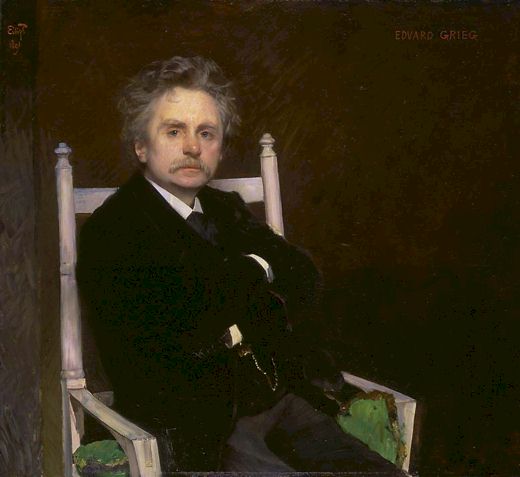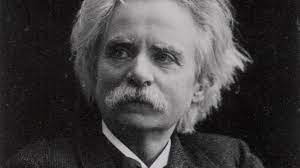Edvard Grieg: A Complete Biography
Introduction
Edvard Grieg (1843–1907) is celebrated as one of Norway’s greatest composers and a central figure in Romantic-era music. His deeply lyrical, folk-influenced style helped establish a unique Norwegian musical identity and influenced generations of musicians across Europe. With works such as the Piano Concerto in A minor and the Peer Gynt suites, Grieg elevated the musical language of his homeland and captured the emotional landscapes of Scandinavia. More than just a national icon, Grieg’s music transcended borders, offering intimate portraits of human emotion that remain powerful to this day.

Childhood
Edvard Hagerup Grieg was born on June 15, 1843, in Bergen, Norway, into a musical and cultured family. His mother, Gesine Judith Hagerup, was a skilled pianist and his first music teacher. She introduced him to the works of Mozart, Chopin, and Beethoven, laying the foundation for his future musical career. His father, Alexander Grieg, served as a British consul and came from Scottish ancestry, which contributed to a broad cultural awareness in the household.
By the age of six, Grieg was already proficient at the piano and composing simple melodies. Though shy and physically fragile—battling pleurisy and other ailments throughout his life—he displayed a natural affinity for music and the arts. His early experiences in Bergen’s vibrant cultural life were crucial in shaping his musical sensibilities, particularly his affinity for Norwegian folk melodies.
Youth
At age 15, Grieg’s talent came to the attention of violinist Ole Bull, a national hero and advocate for Norwegian culture. Recognizing the young boy’s potential, Bull convinced Grieg’s parents to send him to the Leipzig Conservatory in Germany, one of Europe’s most prestigious music schools.
Grieg began his studies at Leipzig in 1858. Although he was exposed to the German classical tradition and studied with respected teachers such as Ignaz Moscheles and Carl Reinecke, he found much of the instruction rigid and uninspiring. Nevertheless, he gained a solid grounding in harmony, counterpoint, and compositional technique.
During his time in Leipzig, Grieg was exposed to the works of Schumann, Mendelssohn, and Wagner, which would have a lasting influence on his musical development. However, it was not until he left Germany that he began to develop his own distinctive voice, rooted in the folk traditions of Norway.
Adulthood
Returning to Scandinavia in the 1860s, Grieg began forging a path as both a composer and conductor. He lived for a time in Copenhagen, where he met Danish composer Niels Gade and Norwegian nationalist writer Bjørnstjerne Bjørnson. Through these relationships, he was introduced to the growing movement for cultural independence in Norway.
In 1867, Grieg married his cousin Nina Hagerup, a talented soprano. Their relationship, though often strained due to financial hardship and his fragile health, was artistically fruitful. Nina was the primary interpreter of many of Grieg’s songs and a source of emotional support throughout his life.
Grieg’s style matured in the 1870s as he began incorporating more explicitly Norwegian elements into his work. His music often reflected his love of nature, his patriotism, and his introspective temperament. Though he suffered from recurring illness—including lung problems and depression—he continued composing and performing, eventually gaining recognition across Europe.
His travels took him to Germany, England, France, and Italy, where he met and was admired by composers such as Franz Liszt, Johannes Brahms, and Peter Tchaikovsky. Despite his success abroad, Grieg always returned to Norway, where he built a home called Troldhaugen near Bergen in 1885. It became both a personal sanctuary and a symbol of his commitment to Norwegian culture.
Major Compositions
Grieg’s oeuvre is diverse, ranging from orchestral and chamber works to songs and piano pieces. Among his most significant works are:
- Piano Concerto in A minor, Op. 16 (1868): Grieg’s only completed concerto, written in Søllerød, Denmark, during a period of personal joy. It features bold Romantic gestures and Norwegian folk dance rhythms. It remains one of the most frequently performed piano concertos in the repertoire.
- Peer Gynt Suites (1875/1888): Originally composed as incidental music for Henrik Ibsen’s play Peer Gynt, these suites include some of Grieg’s most famous melodies, such as “Morning Mood,” “Anitra’s Dance,” and “In the Hall of the Mountain King.” They vividly illustrate narrative scenes through tone painting and regional color.
- Lyric Pieces (1867–1901): This collection of 66 short piano works in 10 volumes represents Grieg’s intimate voice. These pieces, like “Wedding Day at Troldhaugen” and “Arietta,” combine folk motifs with poetic sensitivity, often exploring nostalgic or pastoral themes.
- Holberg Suite, Op. 40 (1884): Written to honor the 200th anniversary of playwright Ludvig Holberg’s birth, this suite fuses Baroque dance forms with Romantic harmonic language, showcasing Grieg’s contrapuntal skill.
- Songs and Choral Music: Grieg composed over 170 songs, many of which are settings of Norwegian poets like Bjørnson and Vinje. His Haugtussa cycle (1895) stands out as a masterful union of poetry and music.
While Grieg’s compositional output was not vast, his works remain popular for their melodic beauty, harmonic freshness, and nationalistic flavor. His contribution to piano literature and his ability to infuse classical forms with folk idioms earned him a distinct place in music history.
Death
Edvard Grieg died on September 4, 1907, in Bergen at the age of 64 from chronic respiratory disease, likely aggravated by years of poor health and exhaustion. His funeral was a national event, attended by over 30,000 people. At his request, his ashes were placed in a mountain tomb near Troldhaugen, overlooking the fjord.
In his final years, Grieg had begun to consider composing a second piano concerto and other large-scale works, but his health prevented their completion. Nevertheless, he left behind a rich legacy that profoundly shaped the direction of Scandinavian music.
Conclusion
Edvard Grieg’s life and work represent a powerful fusion of personal emotion, Romantic aesthetics, and national pride. Through his music, he gave voice to the spirit of Norway and helped define its cultural identity during a time of burgeoning independence. His mastery of melody and his ability to convey subtle emotional nuance continue to inspire listeners and musicians alike.
Grieg once said, “Artists like Bach and Beethoven erected churches and temples on the heights. I only wanted… to build dwellings for men in which they might feel happy and at home.” In fulfilling that vision, Grieg created a musical world of beauty, intimacy, and enduring relevance.

Comments are closed